The secluded 'magic number' stone circle as old as Stonehenge
No road signs point visitors to mystical 5,000-year-old monument just 10 miles from Oxford
Built 4,500 to 5,000 years ago, it’s as old as the Pyramids of Giza and Stonehenge.
But with no signposts and not even a proper car park, the existence of this prehistoric stone circle just outside Oxford isn’t widely known.
Situated down a dead-end land next to a landfill site and recycling centre, The Devil’s Quoits in Stanton Harcourt comprises a circle of 28 monoliths enclosed by an outer embankment and an inner ditch.
The standing stone monument was built in Neolithic times for ceremonial purposes, attracting maybe many hundreds of people to observe or even partake in rituals.
The nature of the ceremonies has been lost to time, but it’s perhaps no coincidence the east and west entrances to the site aligned with the rising and setting sun.
The number of stones may also provide a clue.
In astronomy, 28 is the average number of days it takes for the Sun to complete a full revolution, as well as the number of the days it takes for the Moon to orbit the Earth.
The human menstrual cycle is 28 days, and in maths it is a perfect number.
Fires were lit at the entrances and fragments of bone, both animal and human, were found during excavations.
Being there must have been an awe-inspiring spectacle - and maybe even dangerous.
The area was already a sacred place, with evidence of earlier burials nearby.
It’s thought around 100 people could have constructed the earthworks in three weeks and erected the stones in 10 days, to form a series of similar-sized henges all situated along the River Windrush.
People may have visited them as part of a pilgrimage from the Cotswolds and the west of Britain to the main Thames Valley.
The site at Stanton Harcourt grew over the next 1,000 years, including more than 60 burial mounds, making it one of the densest monument complexes in what was now Bronze Age Britain.
Its modern name came later.
Legend has it the Devil once played quoits with a beggar for his soul, and won by the flinging the giant stones all the way from Wytham.
But medieval farming and the construction of a World War Two airfield, followed by extensive gravel quarrying, meant all that remained of this sacred landscape by the late 20th century was a solitary stone and a slight earthwork.
Thanks to the work of several groups, including Oxford Archaeology, The Devil’s Quoits was rebuilt between 2002 and 2008 to how it might have appeared when the Romans first arrived in Britain 2,000 years ago.
Monoliths that had toppled over or been buried were re-erected, with missing stones replaced by blocks from a local quarry. The earthworks were rebuilt to around half their original height of four metres.
Today, The Devil’s Quoits is a Scheduled Ancient Monument and even featured in the 2020 video game Assassin’s Creed: Valhalla.











